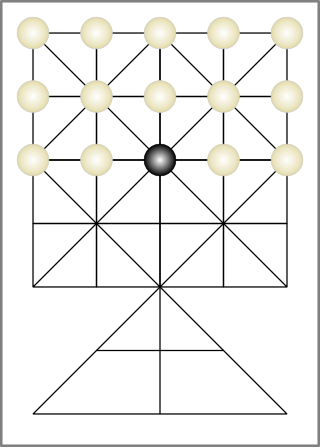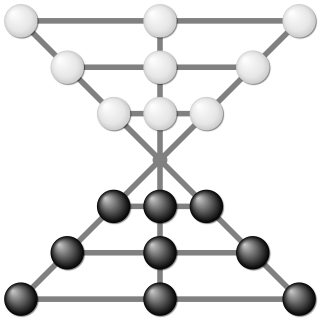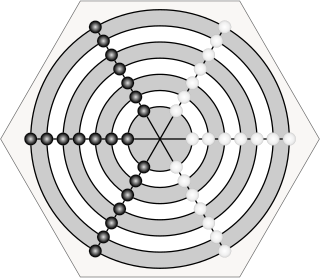
Alquerque is a strategy board game that is thought to have originated in the Middle East. It is considered to be the parent of draughts and Fanorona and the diagonals of its grid are the predecessor of the checkering of the draughts board.
Permainan-Tabal is a two-player abstract strategy board game from Indonesia. The game is sometimes referred to as a cross between alquerque and draughts. It is essentially Draughts played on an expanded alquerque board. It is especially similar to draughts in that the moves of the pieces are strictly forward and sideways until they are promoted to kings by reaching the other player's first rank. The game is also referred to as dama.
Rimau-rimau is a two-player abstract strategy board game that belongs to the hunt game family. This family includes games like bagh-chal, main tapal empat, aadu puli attam, catch the hare, sua ghin gnua, the fox games, buga-shadara, and many more. Rimau-rimau is the plural of rimau which is an abbreviation of the word harimau, meaning 'tiger' in the Malay language. Therefore, rimau-rimau means 'tigers'. The several hunters attempting to surround and immobilize the tigers are called orang-orang, which is the plural of orang, meaning 'man'. Therefore, orang-orang means 'men' and there are twenty-two or twenty-four of them, depending on which version of the game is played. The game originates from Malaysia.
Main tapal empat is a two-player abstract strategy board game from Malaysia. It is a hunt game, and specifically a tiger hunt game since it uses an Alquerque board. The tigers can move as many spaces in a straight line as a clear path allows. Most hunt games have tigers, leopards, or foxes moving only one space at a time. In effect, the tigers in this game have the movement capability of the queen in chess.

Adugo is a two-player abstract strategy game from the Bororo tribe in the Pantanal region of Brazil.
Kaooa is a two-player abstract strategy game first recorded in the central provinces of India. It is a hunt game like rimau, rimau-rimau, main tapal empat, bagha-chall, the fox games, and aadu puli attam. However, what makes kaooa unique is that the board is a five-pointed star or a pentagram. Kaooa is also known as vultures and crows. One vulture goes up against seven crows.

Lau kata kati is a two-player abstract strategy game from India, specifically from Lower Bengal, and also from United Provinces, Karwi Subdivision where it is called Kowwu Dunki, and it was described by H.J.R. Murray in A History of Board-Games Other Than Chess (1952). The game is related to draughts and even more so to Alquerque. Pieces are captured by leaping over them. The board is a pattern of two triangles joined together at a common vertex with further lines subdividing them. It is the same game as Butterfly (game) from Mozambique, which suggests a historical connection between the two games. Lau kata kati belongs to a specific category of games called Indian War-games, and the other games in this category are Dash-guti, Egara-guti, Pretwa, Gol-skuish. All Indian War-games have one important thing in common, and that is that all the pieces are laid out on the patterned board, with only one vacant point in the center. This forces the first move to be played on the central point, and captured by the other player's piece.
Dash-guti is a two-player abstract strategy board game from India, specifically from Central Provinces, United Provinces, Karwi Subdivision where it is called Kowwu Dunki which is the same name given to another similar game called Lau kata kati, and it was described by H.J.R. Murray in A History of Board-Games Other Than Chess (1952). The game is related to Draughts and even more so to Alquerque. Pieces are captured by leaping over them. Dash-guti consists of a Lau kata kati board, but with the addition of two line segments connected to the vertex but exterior to both triangles. Dash-guti belongs to a specific category of games called Indian War-games, and the other games in this category are Lau kata kati, Egara-guti, Pretwa, Gol-skuish. All Indian War-games have one important thing in common, and that is that all the pieces are laid out on the grid patterned board, with only one vacant point in the centre. This forces the first move to be played on the central point, and captured by the other player's piece.
Egara-guti is a two-player abstract strategy game from India, specifically from Central Provinces, and it was described by H.J.R. Murray in A History of Board-Games Other Than Chess (1952). The game is related to Draughts and even more so to Alquerque. Pieces are captured by leaping over them. Egara-Guti consists of a Lau kata kati board, but with the addition of two lines connecting the two triangles and running through them. Egara-guti belongs to a specific category of games called Indian War-games; some other games in this category are Lau kata kati, Dash-guti, Pretwa, Gol-skuish. All Indian War-games have one important thing in common, and that is that all the pieces are laid out on the grid patterned board in the beginning, with only one vacant point in the center. This forces the first move to be played on the central point, and captured by the other player's piece.

Pretwa is a two-player abstract strategy game from Bihar, India, and it was described by H.J.R. Murray in A History of Board-Games Other Than Chess (1952). The game is related to draughts and Alquerque as pieces are captured by leaping over them. The board is composed of three concentric circles divided by three diameters. Pretwa belongs to a category of games called Indian war games, which also includes the games Lau kata kati, Dash-guti, Egara-guti, Gol-skuish. All Indian war games have one important thing in common, and that is that all the pieces are laid out on the board at every intersection point, with the exception of the central point. This forces the first move to be played on the central point, and captured by the other player's piece.

Gol-skuish is a two-player abstract strategy game from India, specifically from Central Provinces, and it was described by H.J.R. Murray in A History of Board-Games Other Than Chess (1952). The game belongs to the draughts and Alquerque family as pieces are captured by leaping over them. The board is composed of seven concentric circles divided by three diameters. Gol-skuish belongs to a specific category of games called Indian War-games which include Lau kata kati, Dash-guti, Egara-guti, and Pretwa. At the beginning of every Indian War-game all the pieces are laid out on the board at every intersection point, with the exception of the central point. This forces the first move of the game to be played on the central point, and captured by the second player's piece.

Komikan is a two-player abstract strategy board game of the Mapuches from Chile and Argentina. The same game is also played by the Incas under the name Taptana, Komina, Comina, Cumi, Puma, or Inca Chess. In modern Quechua, the language of the ethnolinguistic group that are the descendants of the Incas, Taptana means "chess". It is known by the Aymaras, a neighboring ethnolinguistic group to the Quechuan people, as kumisiña. Throughout South America the game is known as El león y las ovejas which literally means "the lion and the sheep". The lion is actually a puma as there are no lions native to the Americas. The Mapuches also call it El Leoncito. J. I. Molina, in 1787, described it as ‘el artificioso juego del ajedrez, al cual dan el nombre de comican’ which translates to "the ingenious game of chess to which they give the name comican". Komikan may actually be the same game as Adugo as played by the Bororó people of Brazil. in 1898, Stewart Culin, the famed anthropologist, named a game played in Peru as Solitario. The same name was also used by the game historian, Murray, in 1952. The game may also be known in Peru as Kukuli. Komikan is a hunt game, and specifically a tiger hunt game since it uses an expanded Alquerque board. Like all hunt games, there are two unequal forces at play. In Komikan, one player has only a single piece, usually called a "puma" or "jaguar", or "kom ikelu", or "leon", which can move one space at a time or capture the other player's pieces by hopping over them. The other player has twelve pieces, or perros or perritos which is Spanish for "dogs" and "little dogs" respectively, that can only move one space at a time, but not capture, and attempts only to surround and immobilize the puma or jaguar. Pieces must move and/or capture following the pattern on the board. The expanded Alquerque board consist of an Alquerque board and a triangular patterned board attached on one of its side.

Buga-shadara, also known as Bouge Shodre, is a two-player abstract strategy board game from Tuva, a republic in Siberia, Russia. It is a hunt game where one player plays the deer. There are two deer usually represented as the black pieces. The boars are also referred black in the referenced article "Buga-shadara a folk game from Tuva". The other player has 24 white pieces with dogs associated to them. The board consist of an Alquerque board flanked on two of its opposite sides by a square patterned board. Because the board is in part an Alquerque board, this makes Buga-shadara a tiger hunt game. What makes Buga-shadara unique among tiger games are the expansion boards on the two opposite sides of the Alquerque board. They are square, whereas most are triangle-like. The word "shadara" resembles the word "shahdara". The "shah" part "is a title given to the emperors/kings and lords of Iran .". There is a place called Shahdara Bagh in Lahore, Punjab, Pakistan, and it's thought that the word "Shahdara can be translated as "the way of kings". Shah translates as "king" and dara translates as the way of kings." The referenced article associates the boars as kings. Perhaps the boars or deer are kings, and have to find a way or have a way with the white pieces or dogs.
Sher-bakar is a two-player abstract strategy board game from Punjab, India. It is a hunt game. It uses an alquerque board, and therefore, sher-bakar is specifically a tiger hunt game. There are two tigers attempting to elude and capture as many of the other player's pieces which in other hunt games in this part of the world is often referred to as a goat, cows, lamb, or men. An interesting and uncommon feature in this game is that the goats, cows, lamb, or men are piled up on four points of the board at the beginning of the game. Piling up pieces is an unusual feature in hunt games or any board game in general. The only other hunt game that uses this feature is Bagh bandi, a game closely related to sher-bakar. Hereinforth, the white pieces will be referred to as goats.
Bagh bandi is a two-player abstract strategy board game from Lower Bengal, India. It is a hunt game. It uses an alquerque board, and therefore, Bagh bandi is specifically a tiger hunt game. There are two tigers attempting to elude and capture as many goats while the goats are attempting to surround and trap the tigers.
Catch the hare is a two-player abstract strategy board game from Europe, and perhaps specifically from Spain. It is a hunt game, and since it uses a standard alquerque board from the game alquerque de doze, it is specifically a tiger hunt game. In some variants, some or all of the diagonal lines are missing which makes it difficult to classify as a tiger game in general. One hare is going up against ten to twelve opponents(hunters or hounds). The hare is the "tiger" in this hunt game which is prey and predator at the same time. The hare can capture the opponents by leaping over them. The opponents attempt to surround and trap the hare.
Kotu Ellima is a two-player abstract strategy board game from Sri Lanka played by the Sinhalese people. The game was documented by Henry Parker in Ancient Ceylon: An Account of the Aborigines and of Part of the Early Civilisation (1909); the game was printed as "Kotu Ellima" which is actually a misspelling because his source for the game was Leopold Ludovici's Journal of the Ceylon Branch of the Royal Asiatic Society (1873), and specifically in the chapter entitled "The Sports and Games of the Singhalese", and Ludovici wrote the name of the game as Kotu Ellime or Taking of the Castles. The game is similar to draughts (checkers) and Alquerque as players hop over one another's pieces to capture them; it is more similar to Alquerque between the two since it uses a standard Alquerque board. However, unlike draughts and standard Alquerque, the game is played on an expanded Alquerque board consisting of four triangular boards attached to the four sides of a standard Alquerque board. It closely resembles peralikatuma and sixteen soldiers which are also played in Sri Lanka and other parts of the Indian subcontinent with the only difference being the number of pieces. In sixteen soldiers, each player has 16 pieces hence the name of the game. In peralikatuma, each player has 23 pieces. In Kotu Ellima, each player has 24 pieces, and at the beginning of the game the whole board is covered with them except the central point reminiscent of standard alquerque.
Tiger and buffaloes is a two-player abstract strategy board game from Myanmar. It belongs to the hunt game family. The board is a 4x4 square grid, where pieces are placed on the intersection points and move along the lines. It is one of the smallest hunt games. Three tigers are going up against eleven buffaloes. The tigers attempt to capture as many of the buffaloes by the short leap as in draughts or alquerque. The buffaloes attempt to hem in the tigers.
Sua ghin gnua is a two-player abstract strategy board game from Thailand, formerly known as Siam. Another name for the game is tigers and oxen. It is a hunt game played on a 5x5 square grid with only orthogonal lines. One player plays the three tigers, and the other player plays the twelve oxen. The board is empty in the beginning. Players first drop their pieces onto the board, and then are able to move them. The tigers can capture the oxen by the short leap as in draughts and alquerque, but the oxen attempt to elude and at the same time hem in the tiger. Sua Ghin Gnua most resembles the tiger hunt games such as bagh-chal, rimau-rimau, main tapal empat, catch the hare, and adugo since they all use a 5 x 5 square grid. But tiger games technically consist of a standard alquerque board which is a 5 x 5 square grid with several diagonal lines criss-crossing through it which are completely missing in sua ghin gnua. There are however some variants of catch the hare which have missing diagonal lines also. Another game that resembles sua ghin gnua is from Myanmar, called tiger and buffaloes, which is a hunt game consisting of a 4 x 4 square grid with no diagonal lines. Myanmar happens to border Thailand geographically so there might be a historical connection between the two games. Another game from Myanmar is lay gwet kyah that is presumed to be similar to sua ghin gnua. Sua ghin gnua was briefly described by Stewart Culin, in his book Chess and Playing Cards: Catalogue of Games and Implements for Divination Exhibited by the United States National Museum in Connection with the Department of Archaeology and Paleontology of the University of Pennsylvania at the Cotton States and International Exposition, Atlanta, Georgia 1895 (1898). It's also briefly mentioned by H.J.R. Murray in his book A History of Chess (1913). It was also described by R.C. Bell, in his book Board and Table Games from Many Civilizations (1969).

The tiger game is a traditional Chinese board game. It is a strategy game for two players. One player, who plays the tiger, has only one piece. The other player has 18 men. The tiger must eat the men, who must block the tiger so that he cannot move. The game can be played with any kind of pieces that can be distinguished from one another. The board is 8×8 squares, with the addition of a square of 2×2 squares, which is called the tiger's lair.











